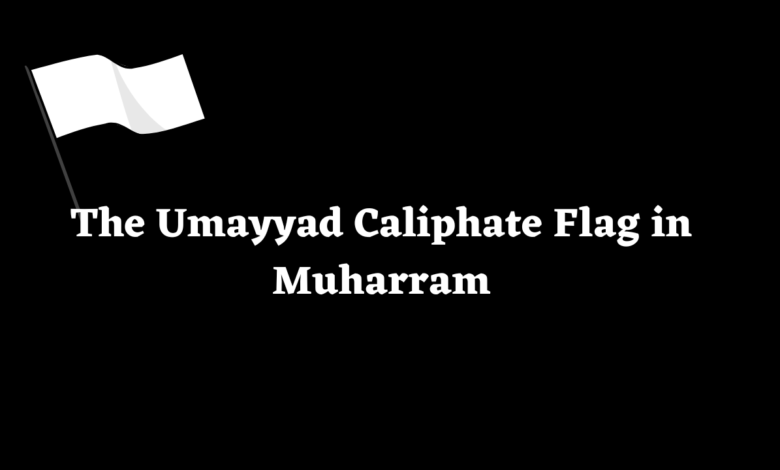What do you know about Umayyad Caliphate Flag

Introduction
Muharram, the first month of the Islamic lunar calendar, carries deep significance for Muslims worldwide. It marks the beginning of the Islamic New Year and is a time of reflection and remembrance. During this month, Muslims from different sects observe various practices, with Ashura being one of the most pivotal days. On this day, Shia Muslims, in particular, commemorate the tragic events of Karbala, where Imam Hussein and his companions were martyred.
Throughout history, flags have played a crucial role in representing the identity and legacy of different empires and caliphates. In the context of Muharram, the Umayyad Caliphate flag holds a unique place due to its association with the events surrounding Karbala. This article delves into the history, symbolism, and controversies surrounding the Umayyad Caliphate flag during the month of Muharram.
The Umayyad Caliphate and its Flag
The Umayyad Caliphate, established in 661 CE, was the second Islamic caliphate after the Rashidun Caliphate. Under their rule, the Islamic empire expanded significantly, encompassing vast territories, including present-day Spain, North Africa, the Middle East, and parts of Central Asia.
The flag of the Umayyad Caliphate was known as the “Black Standard” (Rayat as-Sawda), and it bore great historical significance. Its black color is believed to have been chosen because it represented mourning and grief. Moreover, it became emblematic of the power and dominance of the Umayyad rulers. The Black Standard was adorned with various insignias, including religious symbols, to signify their authority and adherence to Islam.
The Controversy Surrounding the Umayyad Flag and Muharram
During the events of Karbala in 680 CE, the Umayyad forces under the command of Yazid I, the Umayyad Caliph at the time, were responsible for the martyrdom of Imam Hussein and his companions. This tragedy has left a profound impact on the Muslim world, especially on Shia Muslims, who regard Imam Hussein’s sacrifice as a symbol of resistance against tyranny and oppression.
The association of the Umayyad Caliphate flag with the events of Karbala has led to controversies, particularly during the month of Muharram. For Shia Muslims, the Umayyad flag symbolizes the oppression and injustice faced by Imam Hussein and his followers. As a result, the flag has become a potent representation of the struggles against tyranny and a reminder of the calamities that befell the family of Prophet Muhammad (peace be upon him).
Shia Muharram Observances and the Umayyad Flag
During Muharram, Shia Muslims engage in various rituals to mourn the martyrdom of Imam Hussein and his companions at Karbala. They conduct processions and gatherings where participants often carry flags, banners, and replicas of the Black Standard. These flags bear religious inscriptions and images, serving as powerful symbols of remembrance and solidarity with the suffering of Imam Hussein.
The presence of the Umayyad flag replicas during Muharram processions is meant to invoke emotions and draw parallels between the past injustices and present struggles for justice and righteousness. It reinforces the commitment to standing against oppression and tyranny, as exemplified by Imam Hussein’s stance at Karbala.
Calls for Sensitivity and Understanding
While the use of the Umayyad Caliphate flag during Muharram processions holds deep significance for Shia Muslims, it has also sparked debates and controversies. Some argue that displaying the flag could perpetuate sectarian divisions and animosities among Muslims. They believe that focusing on the divisive aspects of history might hinder efforts for unity and understanding among various Islamic sects.
However, proponents of using the Umayyad flag during Muharram argue that it serves as a historical reminder and a rallying symbol against oppression and injustice. They believe that it reinforces the core message of Imam Hussein’s sacrifice, promoting empathy, and encouraging Muslims to stand up for justice and righteousness.
Conclusion
Muharram, the first month of the Islamic calendar, holds immense significance for Muslims worldwide. It is a time of remembrance, reflection, and observance of various traditions and practices. For Shia Muslims, Muharram is a period of intense mourning and remembrance of the tragic events of Karbala.
The Umayyad Caliphate flag, known as the Black Standard, plays a significant role during Muharram processions among Shia communities. It symbolizes the historical injustices and oppression faced by Imam Hussein and his followers during the events of Karbala. The flag serves as a reminder of the ongoing struggles for justice and righteousness, reflecting the core values of Islam.
While the use of the Umayyad flag in Muharram has sparked debates, it is crucial to approach these discussions with sensitivity and understanding. As Muslims, it is essential to focus on the universal messages of peace, justice, and unity, which are at the heart of Islam, and use such historical symbols as a means to promote these values. By doing so, Muharram can become a time of spiritual growth, empathy, and coming together as a community to honor the legacy of Imam Hussein and remember the lessons he imparted through his sacrifice.
What is the Umayyad Caliphate Flag?
The Umayyad Caliphate Flag is a historical symbol associated with the Umayyad dynasty, one of the early Islamic caliphates. It represents the political and territorial legacy of the Umayyad Caliphate, which ruled over a vast empire encompassing parts of present-day Middle East, North Africa, and Spain during its heyday.
Why is the Umayyad Caliphate Flag relevant to Muharram?
The Umayyad Caliphate Flag becomes relevant to Muharram due to its association with the events of the Battle of Karbala. The Umayyad Caliphate was in power during the time of the tragic events at Karbala, where Imam Hussein, the grandson of Prophet Muhammad (peace be upon him), and his companions were martyred. As a result, the Umayyad flag represents the oppressive forces against which Imam Hussein and his followers stood up to defend justice and truth.
How is the Umayyad Caliphate Flag viewed in Muharram?
The Umayyad Caliphate Flag is seen as a symbol of historical and political significance during Muharram. For Sunni Muslims, it may represent the broader Islamic heritage and the history of their caliphates. However, for many Shia Muslims, the flag is a reminder of the oppressive regime that played a role in the tragedy of Karbala, where the family of Prophet Muhammad (peace be upon him) faced persecution and injustice.
Are there controversies surrounding the Umayyad Caliphate Flag in Muharram?
Yes, the Umayyad Caliphate Flag’s use in Muharram can be a source of controversy, particularly among Shia Muslims. Since the Umayyad Caliphate is historically linked to the events of Karbala, some Shia communities view the flag as a symbol of oppression and tyranny. As a result, its display during Muharram processions or events may evoke strong emotions and resistance from Shia Muslims who associate it with the suffering and martyrdom of Imam Hussein.
What are some alternative symbols used during Muharram?
In Muharram, especially among Shia Muslims, other symbols are commonly used to commemorate the events of Karbala. These symbols include the black banner (Alam) and replicas of the shrines in Karbala. These symbols serve to remember the suffering and sacrifice of Imam Hussein and his companions, without evoking the historical associations of the Umayyad Caliphate Flag.
How is the Umayyad Caliphate Flag used during Muharram?
In Muharram, especially among Shia Muslims, other symbols are commonly used to commemorate the events of Karbala. These symbols include the black banner (Alam) and replicas of the shrines in Karbala. These symbols serve to remember the suffering and sacrifice of Imam Hussein and his companions, without evoking the historical associations of the Umayyad Caliphate Flag.
How can one be respectful during Muharram with regards to these symbols?
To be respectful during Muharram, it’s essential to understand the sensitivity surrounding these symbols and their historical context. If you are a non-Muslim or belong to a different Islamic sect, avoid using or displaying the Umayyad Caliphate Flag in Shia-majority areas during Muharram events. Instead, be mindful and considerate of the local customs and symbols used during this period of mourning and remembrance.





